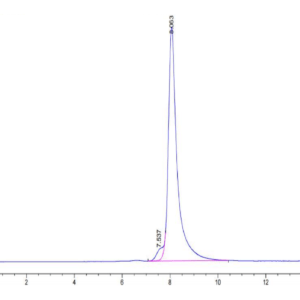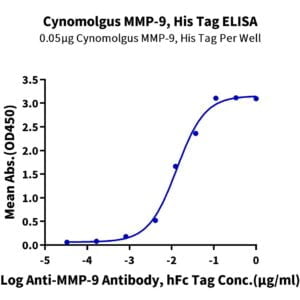| Weight | 1 lbs |
|---|---|
| Dimensions | 9 × 5 × 2 in |
| accession | P16422 |
| express system | HEK293 |
| product tag | C-hFc |
| purity | > 95% as determined by Tris-Bis PAGE;> 95% as determined by HPLC |
| background | Epithelial Cellular Adhesion Molecule (EpCAM), also known as KS1/4, gp40, GA733-2, 17-1A, and TROP‑1, is a 40 kDa transmembrane glycoprotein that consists of a 242 amino acid (aa) extracellular domain with two EGF‑like repeats, a 23 aa transmembrane segment, and a 26 aa cytoplasmic domain. |
| molecular weight | The protein has a predicted MW of 54.2 kDa. Due to glycosylation, the protein migrates to 60-70 kDa based on Tris-Bis PAGE result. |
| available size | 100 µg, 500 µg |
| endotoxin | Less than 1EU per μg by the LAL method. |
Human EpCAM/TROP1 Protein 4214
$195.00 – $650.00
Summary
- Expression: HEK293
- Functional: Yes (ELISA)
- Amino Acid Range: Gln24-Lys265
Human EpCAM/TROP1 Protein 4214
| protein |
|---|
| Size and concentration 100, 500µg and lyophilized |
| Form Lyophilized |
| Storage Instructions Valid for 12 months from date of receipt when stored at -80°C. Recommend to aliquot the protein into smaller quantities for optimal storage. Please minimize freeze-thaw cycles. |
| Storage buffer Shipped at ambient temperature. |
| Purity > 95% as determined by Tris-Bis PAGE |
| target relevance |
|---|
| Epithelial Cellular Adhesion Molecule (EpCAM), also known as KS1/4, gp40, GA733-2, 17-1A, and TROP-1, is a 40 kDa transmembrane glycoprotein that consists of a 242 amino acid (aa) extracellular domain with two EGF-like repeats, a 23 aa transmembrane segment, and a 26 aa cytoplasmic domain. |
| Protein names Epithelial cell adhesion molecule (Ep-CAM) (Adenocarcinoma-associated antigen) (Cell surface glycoprotein Trop-1) (Epithelial cell surface antigen) (Epithelial glycoprotein) (EGP) (Epithelial glycoprotein 314) (EGP314) (hEGP314) (KS 1/4 antigen) (KSA) (Major gastrointestinal tumor-associated protein GA733-2) (Tumor-associated calcium sign |
| Gene names EPCAM,EPCAM GA733-2 M1S2 M4S1 MIC18 TACSTD1 TROP1 |
| Protein family EPCAM family |
| Mass 9606Da |
| Function May act as a physical homophilic interaction molecule between intestinal epithelial cells (IECs) and intraepithelial lymphocytes (IELs) at the mucosal epithelium for providing immunological barrier as a first line of defense against mucosal infection. Plays a role in embryonic stem cells proliferation and differentiation. Up-regulates the expression of FABP5, MYC and cyclins A and E. |
| Subellular location Lateral cell membrane ; Single-pass type I membrane protein. Cell junction, tight junction. Note=Colocalizes with CLDN7 at the lateral cell membrane and tight junction. |
| Tissues Highly and selectively expressed by undifferentiated rather than differentiated embryonic stem cells (ESC). Levels rapidly diminish as soon as ESC's differentiate (at protein levels). Expressed in almost all epithelial cell membranes but not on mesodermal or neural cell membranes. Found on the surface of adenocarcinoma. |
| Structure Monomer. Interacts with phosphorylated CLDN7. |
| Post-translational modification Hyperglycosylated in carcinoma tissue as compared with autologous normal epithelia. Glycosylation at Asn-198 is crucial for protein stability. |
| Target Relevance information above includes information from UniProt accession: P16422 |
| The UniProt Consortium |
Data
Publications
Publications
| pmid | title | authors | citation |
|---|---|---|---|
| We haven't added any publications to our database yet. | |||
Protocols
| relevant to this product |
|---|
Documents
| # | ||
|---|---|---|
| Please enter your product and batch number here to retrieve product datasheet, SDS, and QC information. | ||


















